Ever pondered the secret to impeccably finished wood? The answer might be linseed oil. But is it a magic elixir or a double-edged sword? Let’s uncover the truth.
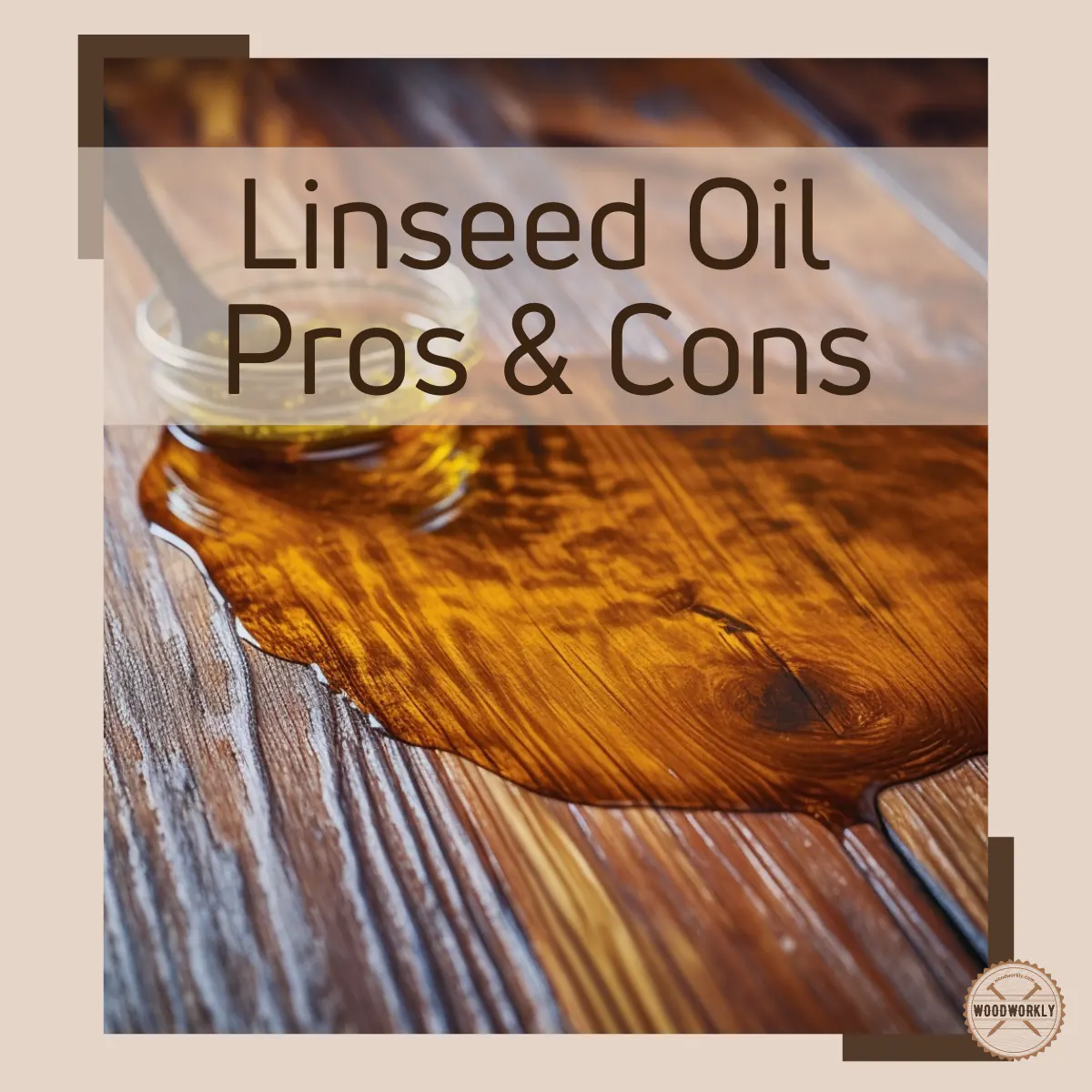
Linseed oil also known as flaxseed oil is one of the most popular wood finishing oil that can be used for any woodworking project.
It is extracted from flaxseeds and is considered an eco-friendly non-toxic finishing oil.
It has significant qualities over other finishes as an ideal protective finish that protects your wood furniture while enhancing its natural beauty.

If you’re interested in a Linseed oil finish, it’s worth having a look at, Linseed oil Advantages and Disadvantages.
| Advantages | Disadvantages |
| Enhance wood appearance | Need regular maintenance |
| Hide dents and scratches | Time-consuming |
| Food safe | Yellows over time |
| Non-toxic | No UV resistance |
| Easy to apply | Support mildew growth |
| Water-resistant | Susceptible to water rings |
| Eco-friendly | |
| Elasticity | |
| Can use as a wood conditioner |
But that’s a quick snapshot.
So, let’s discuss each advantage and disadvantage of Linseed oil separately in detail.

Advantages Of Linseed Oil
1. Enhance the Wood’s Appearance
Linseed oil enhances the natural color of the wood. It brings out the depth of the wood color and texture in wood grain and adds a unique appearance to your furniture and woodwork.
Both interior and exterior woodworks and furniture get a fresh wet look with Linseed oil that lasts for so long with proper maintenance.
Linseed oil provides a golden color hue that provides a luxury-rich look to furniture.
This golden hue color will eventually turn into a beautiful amber color. compared to other finishes Linseed oil is popular for highlighting the natural beauty of the wood.
Linseed oil absorbs deep into the wood and improves the look.
The extra sheen and glossiness help to increase the beauty and appearance of any kind of interior and exterior wood.
2. Hide Dents and Scratches
Linseed oil is helpful to hide scratches and dents. Linseed oil is so helpful in wood flooring because floors get scratches, marks, and dent a lot due to foot traffic and pet scratches especially if you used softwood material for flooring.
By hand rubbing Linseed oil with a clean rag, you’ll be able to vanish those scratches and able to give a nice clean polished look to floors and other furniture.
Linseed oil is great for antique furniture to bring back its original look without any unpleasant scratch marks.
Linseed oil fills small cracks, and scratches in wooden surfaces and avoid water particles from going inside the wood which can cause wood to rot.
This is helpful for bathroom furniture and kitchen utensils because they work in a high-moisture environment.
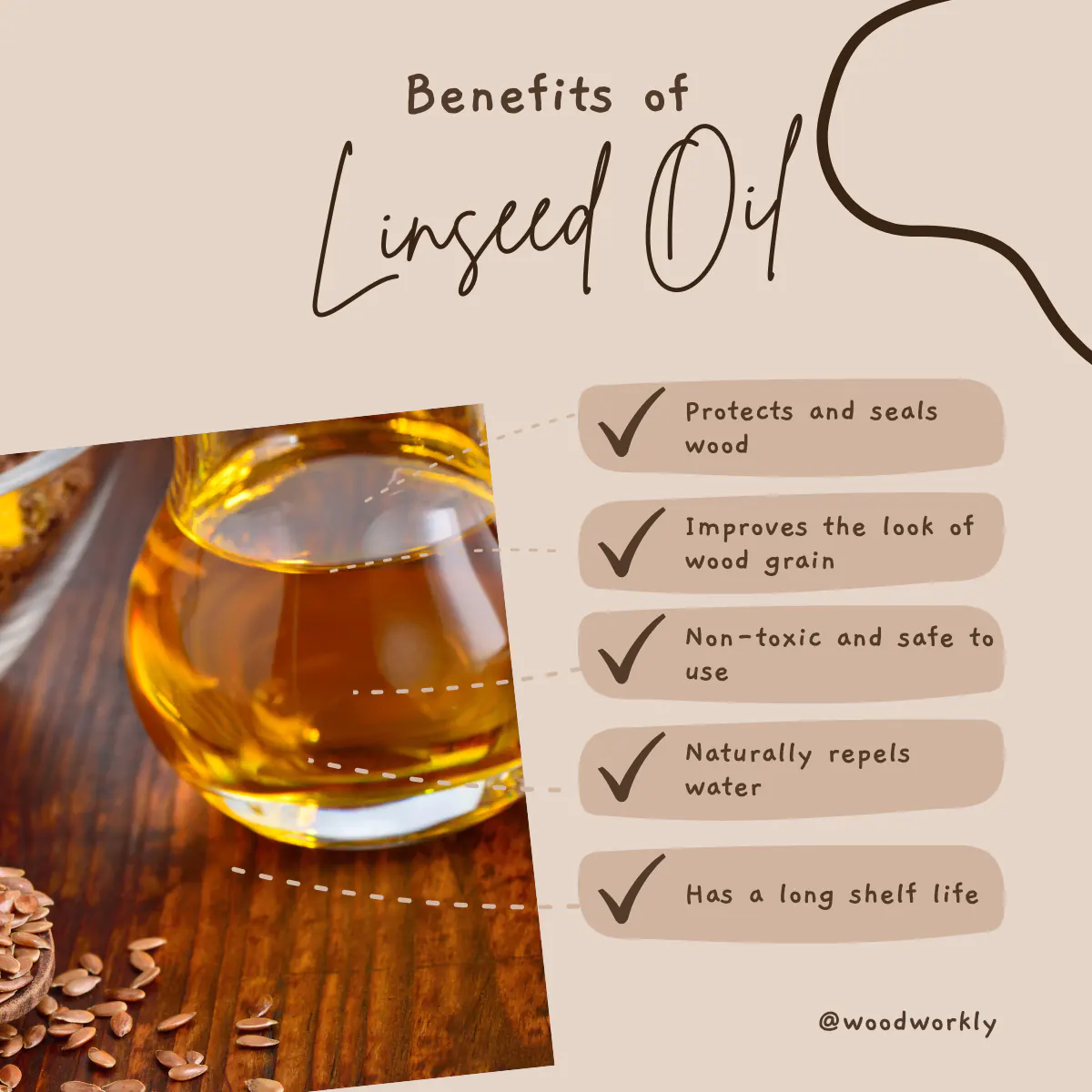
3. Food Safe
Linseed oil is food safe and can apply to any wooden surface directly in contact with food and meals.
Raw Linseed oil is food grade but boiled Linseed oil is extremely harmful and not food safe.
Therefore, only use raw Linseed oil on kitchen utensils, bowls, spoons, and other wooden equipment.
Because of being natural and extracted from flaxseed, Linseed oil doesn’t contain any harmful ingredients, chemicals, and hazardous items that can be harmful to you and the environment.
Because of being food-safe finish, Linseed oil can use for cutting boards, butcher blocks, and kitchen countertops without any issue.
It gives a nice, beautiful appearance to your cutting boards with extra protection from environmental elements such as moisture.
Linseed oil is one of a few kinds of finish that can use for cutting boards without any fear since popular finishing oils like Teak oil, Danish oil cannot be considered as food grade finishing oil since they contain harmful chemicals such as varnish, turpentine, and mineral spirits.
Even though raw Linseed oil is food safe make sure to check the manual or instruction label before applying it on cutting boards because nowadays some synthetic Linseed oils use chemicals and they have mentioned whether it’s food safe or not in the bottle label.
As you can see Linseed oil is a versatile multi-purpose finishing oil that can be applied on any surface without considering much.
4. Non-toxic
Linseed oil is a non-toxic finishing oil since it is an organic oil that comes from nature by crushing flaxseeds.
It doesn’t contain VOCs or any other artificial chemicals.
Because of being non-toxic Linseed oil can be used to finish kitchen utensils and children’s toys.
Make sure to apply Linseed oil and let it dry and cure for at least a week before using it because Linseed oil takes lots of time to get hardened.
Linseed oil has good resistance against insects, pests, and fungi attacks. Therefore, it can apply to any woodworking project and cause no harmful effects on our health and safety.
Linseed oil is not harmful to plants and animals. Therefore, it can use to finish your beautiful garden beds and birdhouses, and animal cages.
Linseed oil hardens upon exposure to the air.
It reacts with atmospheric oxygen and goes through an oxidation process while releasing some amount of heat which is not harmful to people and most animals.

5. Easy To Apply
Linseed oil is easy to apply on any wooden surface since it is a hand-rubbed finish. You can apply Linseed oil with a bristle brush or lint-free cloth to get an excellent finish quickly.
Make sure to apply it along the direction of the wood grain for better penetration into wood fibers and provide a nice sheen.
If you use boiled Linseed oil, apply a minimum of 3 coats to get better results according to your wood type. After each coat leaves the surface to dry completely for at least more than 3 – 4 days.
Yes! That’s too much. Linseed oil dries extremely slowly compared to other finishing oils like Danish oil, Tung oil, and Teak oil.
When you feel the surface is ok to touch without smear, do the second coating and repeat the drying process in a well-ventilated area.
Let’s find out how to apply Linseed oil to wood,
- Take your wood furniture or woodwork to a well-ventilated area.
- Clean the wooden surface and eliminate dust, dirt, and grime.
- Sand the entire surface with 120-grit sandpaper.
- Clean and remove sawdust with clean rags.
- Pour and soak a rag with Linseed oil.
- Wipe through the whole surface along the direction of the wood grain.
- Let the first coat absorb well into the wood and wipe excess oil for a better finish
- Let it dry for 24 hours.
That’s it! Those are the 10 simple steps to apply Linseed oil without getting any blotches, streaks, or tacky surfaces.
6. Water Resistant
Linseed oil repels water and is hydrophobic. It has good resistance against moisture and water particles.
But Linseed oil is not waterproof.
Therefore, Linseed oil is able to protect the wood from water damage but under high moisture or water content, you can’t keep hope on Linseed oil because the protection breaks under a high moisture environment.
Linseed oil can use for indoor moisture environments such as bathrooms and kitchens. It can prevent moisture and water droplets from going inside the wood.
But outside you better keep an eye on the Linseed oiled surface because it cannot protect the wood from heavy rains.
Linseed oil is great for both indoor and outdoor furniture.
But make sure to cover up or keep your Linseed oil-finished outdoor furniture in a covered area in harsh weather conditions to prevent water damage.
If water particles break the barrier and penetrate the wooden surface, the wood may start to rot from the inside.
Therefore, make sure to apply sealer or wax on top of the Linseed oil coatings for better protection from moisture.
Because of not having the waterproofing ability, Linseed oil helps the growth of mildew.
Environmental high moisture content combines with Linseed oil and encourages the growth of mildew and mold.
Mold and mildew can damage your loved furniture and hard to recover.

7. Eco-Friendly
Linseed oil is sustainable and biodegradable finishing oil. It has no harmful ingredients or chemicals that damage and challenge the environment.
If you’re a nature lover, Linseed oil is the best wood finishing oil you should go with. It doesn’t contain or release environmentally hazardous items.
Most of the finishing oils release heavy metals, lead acetate, and cobalt-manganese chemicals which are not safe for the environment.
Drying agents are what help wood finishes to dry faster. But on the other hand, they are the ones that damage the environment.
Raw and boiled Linseed oil is totally free from drying agents.
Therefore, usually, they take a lot of time to dry, but on the other hand, they have no impact on the environment.
Linseed oil is volatile and contains zero petroleum derivatives or heavy metals, and is 100% biodegradable.
They are the best eco-friendly finishing oils available in the market.
8. Elasticity
Linseed oil has good stretchability and elasticity.
When the wood contract and expand due to temperature changes, humidity changes, and physical and chemical effects, the applied Linseed oil layer will adjust its shape accordingly.
This is because of its polymerized flexible behavior.
Wood expands with heat and contracts with cold. Plus, it expands in highly humid weather and contract in less humidity.
So, the finisher needs to have a good connection with wood fibers to keep steady without losing its connection with the wooden surface even under extreme conditions.
Linseed oil does its part well because of its elastic behavior.
Even though Linseed oil hardens and makes an excellent stabilized layer over the wooden surface, it has the ability to expand and contract with wood movements without losing its stability.
This makes Linseed oil great as a finisher and versatile.
The elasticity of Linseed oil remains the same even after its fully cured and turned into a fully polymerized state.
Because of being so flexible and compatible with wooden surfaces, Linseed oil resists cracking, and peeling and can tolerate wear and shear forces without losing its stability.
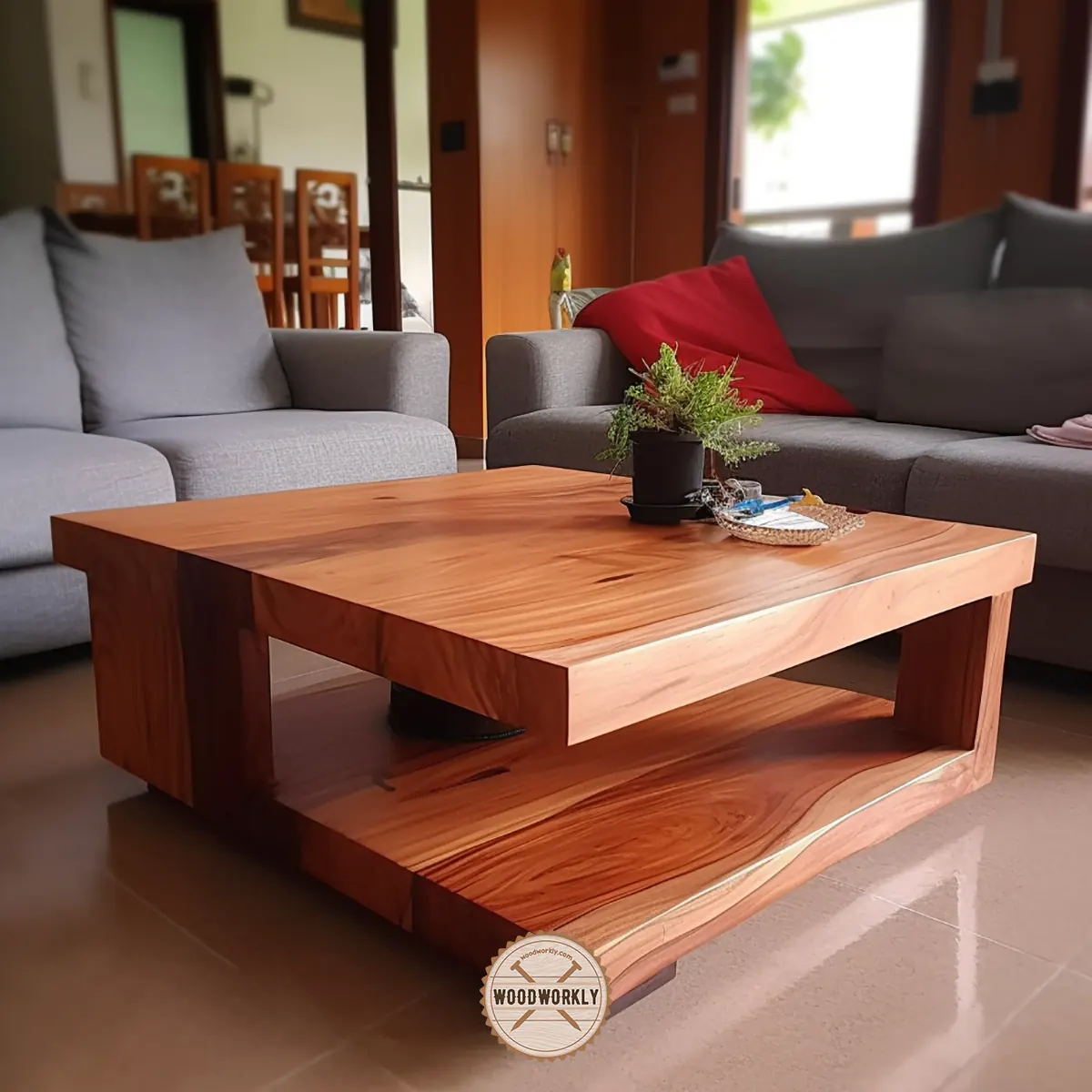
9. Can Use as A Wood Conditioner
Linseed oil can be used as a wood conditioner. You can use Linseed oil as a wood conditioner before painting and staining.
It will make the wooden surface saturated and helps to spread out stains evenly avoiding wood staining mistakes such as blotches and streaks.
If you’re working on wood like pine, birch, and poplar, they are hard to stain because they don’t hold stains well as cedar and aspen.
By applying Linseed oil before staining, you will ably apply stain on any wood without considering the wood type because Linseed coat holds stain well and helps to color the wood with extra protection from moisture.
Apply Linseed oil on porous wood that soaks up stains like a sponge.
Generally wood conditioners and expensive and you need to follow a special method to apply commercial wood conditioners.
Read to know, What wood conditioners do in detail!
By mixing Linseed oil with turpentine, you’ll be able to make a wood conditioner of your own and apply it to any wood before staining.
After applying Linseed oil as a wood conditioner wait for a minimum of 24 hours to dry it completely before applying wood stain for better results.
Now you have a clear idea about the benefits of using Linseed oil as a finisher.
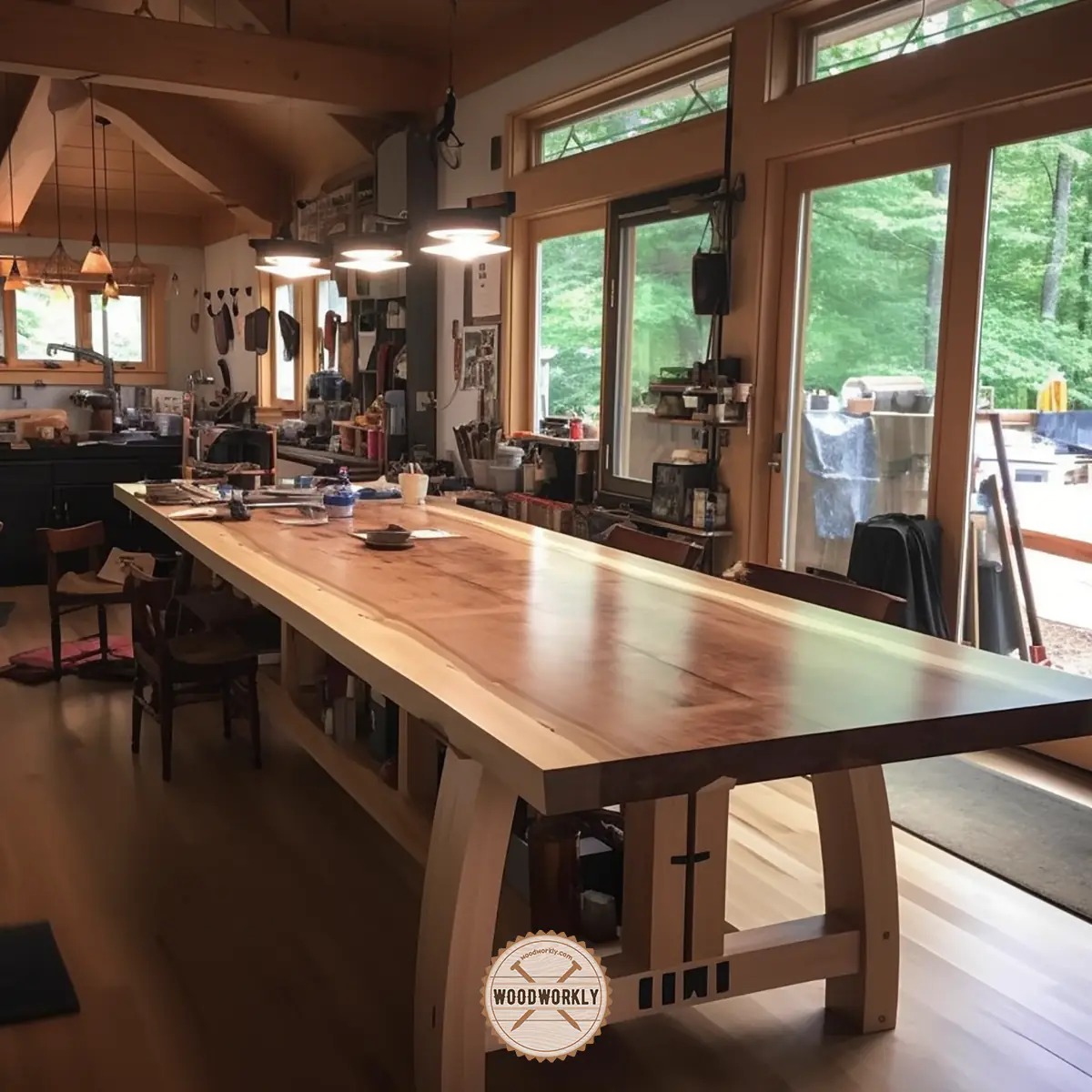
So, let’s head into its disadvantages and how to minimize those during the application process.
Disadvantages Of Linseed Oil
1. Need Regular Maintenance
Regular maintenance is an essential task when working with Linseed oil. The linseed oil layer needs to be cleaned regularly to keep it longer.
Linseed oil is not permanent and you need to apply a minimum of 2 coats every two years.
When you’re reapplying Linseed oil, make sure to sand down the previously applied layer completely, clean the surface well, and start from the beginning.
This will help you to achieve a nice appearance with excellent protection.
Linseed oil has a polymeric structure that can attract dust particles that are so hard to remove.
This can result in a dull unpleasant look and regular cleaning is a must to retain the shine forever.
Clean the Linseed oil surface with a shammy cloth and wipe dull areas. To repair cracks and scratches, reapply Linseed oil coatings.
2. Time Consuming
You need to apply a minimum of 3 coats of Linseed oil to get nice looking finish with excellent protection from environmental elements.
But this takes lots of time because Linseed oil takes absorbs slowly into wood fibers. This is so time-consuming and patience is the key when working with Linseed oil.
After applying each coat, you need to wait for 2 – 3 days until it’s completely dry before applying the next coat.
This is so frustrating since Linseed oil is one of the slowest drying oils in the woodworking world. Danish oil, Tung oil, and Teak oil dry faster than Linseed oil.
This drying time can change due to wood type and environmental humidity. If the environmental humidity is high, the drying time can take even more than a week.
Let the previously applied Linseed oil coat dry completely before applying another coat to avoid getting botches and streaks.
During each coating, sanding is required to gain a nice and super smooth finish.
Also, recommend applying at least 3 coats for most woodwork which may consume a lot of time.
After the final Linseed oil coat, let it cure for several days before using it.
This is helpful to give enhancing the appearance and maximum protection for your loving furniture and woodwork.

3. Yellows Over Time
Linseed oil tends to be slightly yellow over time. This is one of the major drawbacks of using Linseed oil.
Under direct sunlight, the Linseed oil coating tends to turn yellow, and this won’t appear in indoor furniture.
Linseed oil turns yellow because of temperature changes, humidity, type of light and excess exposure to light, excess darkness, chemical exposure, pigments, and because of impurities.
To minimize most of the causes of yellowing of Linseed oil, purchase it from a quality manufacturer.
To fix Linseed oil yellowing, you’ll have to remove the previous coating and apply a new one on top of that and make sure to keep your Linseed oil-applied furniture in a covered area for better protection.
Or you can apply sealer, wax, or stain on top of the Linseed oil coatings to prevent Linseed oil from yellowing.
4. No UV resistance
Linseed oil has no UV resistance since it doesn’t have UV filters or UV pigments to absorb UV light and prevent them from going inside the wood.
Therefore, Linseed oil applied furniture should not keep under direct sunlight.
UV light can easily damage the wooden surface through Linseed oil coatings and crack and spit the wood.
Plus, UV light may cause wood to grow mildew, fungus, and getting insect attacks.
If you need UV resistance from your wood finish for exterior furniture, better to go for Teak oil or Danish oil because they have UV pigments that help to protect furniture from harmful UV light.
Because of having no UV resistance, most people tend to apply Linseed oil only on interior furniture, woodwork, and wood carvings.
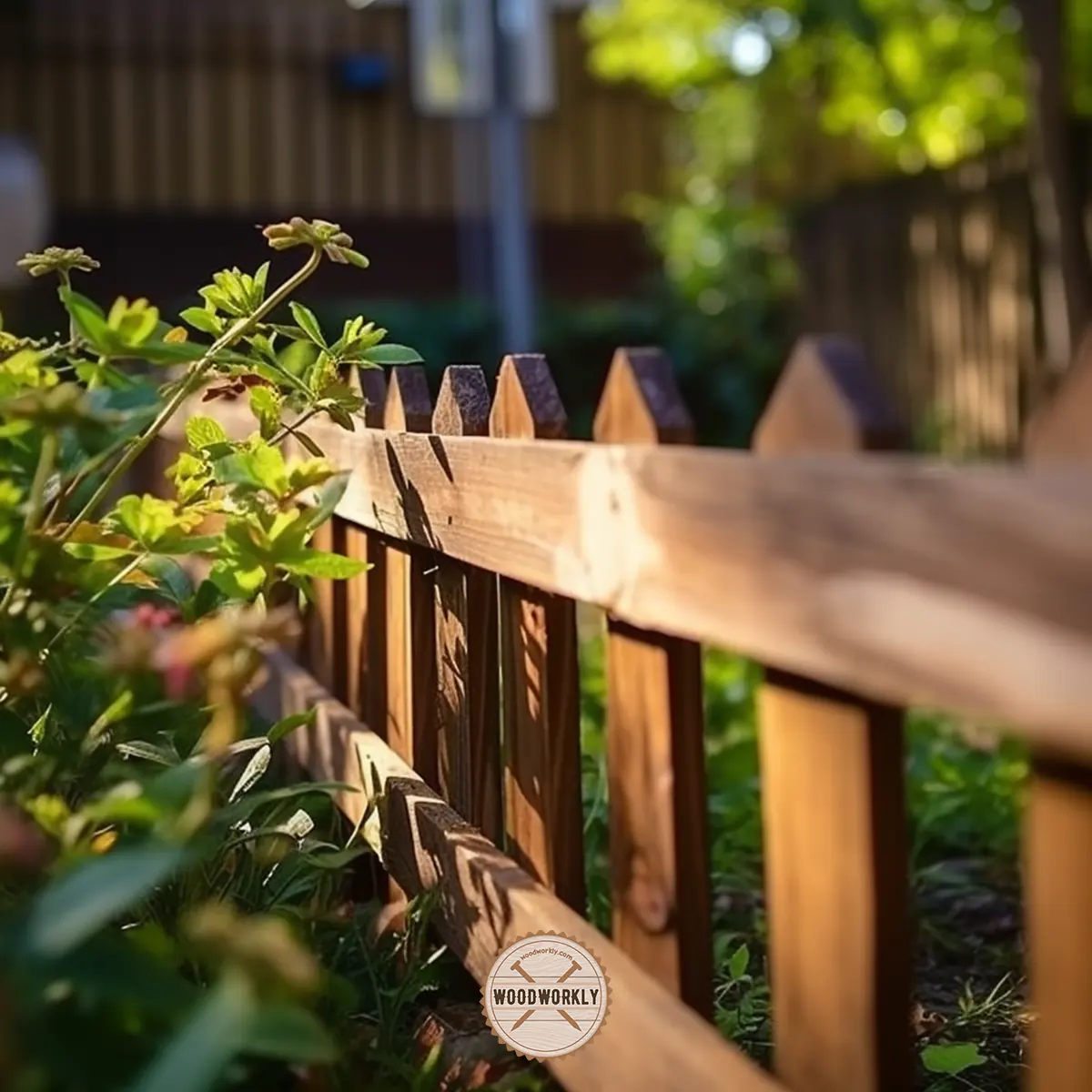
5. Support the Growth of Mildew
Linseed oil helps to grow mildew on woodwork and furniture since Linseed oil is a good food source for molds.
Most Linseed oil purchases from local stores cause the growth of mildew once they are mixed with mineral spirits. But generally, the DIY stain doesn’t have mildew issues.
High humidity is also a reason for the growth of mildew on the Linseed oil surface.
You can prevent mildew growth with chlorine and bleaching products. But this might damage the wood as well.
So, here’s what I recommend to stop mildew growth on the Linseed oil surface,
If you want to kill mildew spores on the Linseed oil surface, apply a high-quality stain on top of the Linseed oil coatings.
Because mildew can cause wood discoloration and give an unpleasant appearance while reducing the protection of the wood.
Regular maintenance is the key to avoiding molds and algae and keeping your Linseed oil coating and furniture protected from mildew.
6. Susceptible To Water Rings
Never place cold glasses on the Linseed oiled surface because Linseed oil is only water repellent, and it cannot protect the wood from water damage.
Therefore, watermarks on the surface don’t go away easily if they are left for so long.
Therefore, better to wipe the watermarks as soon as possible to avoid getting water rings on the furniture surface. This is issue is common for both pure and boiled Linseed oils.
Once the water evaporated from the surface, it leaves lighter color rings on the Linseed oil surfaces.
If the water rings didn’t go off after wiping, you’ll probably have to sand the affected area to remove the water rings.
Then apply Linseed oil coating again.
That’s it, folks! Now you have deep knowledge about the advantages and disadvantages of Linseed oil with examples.
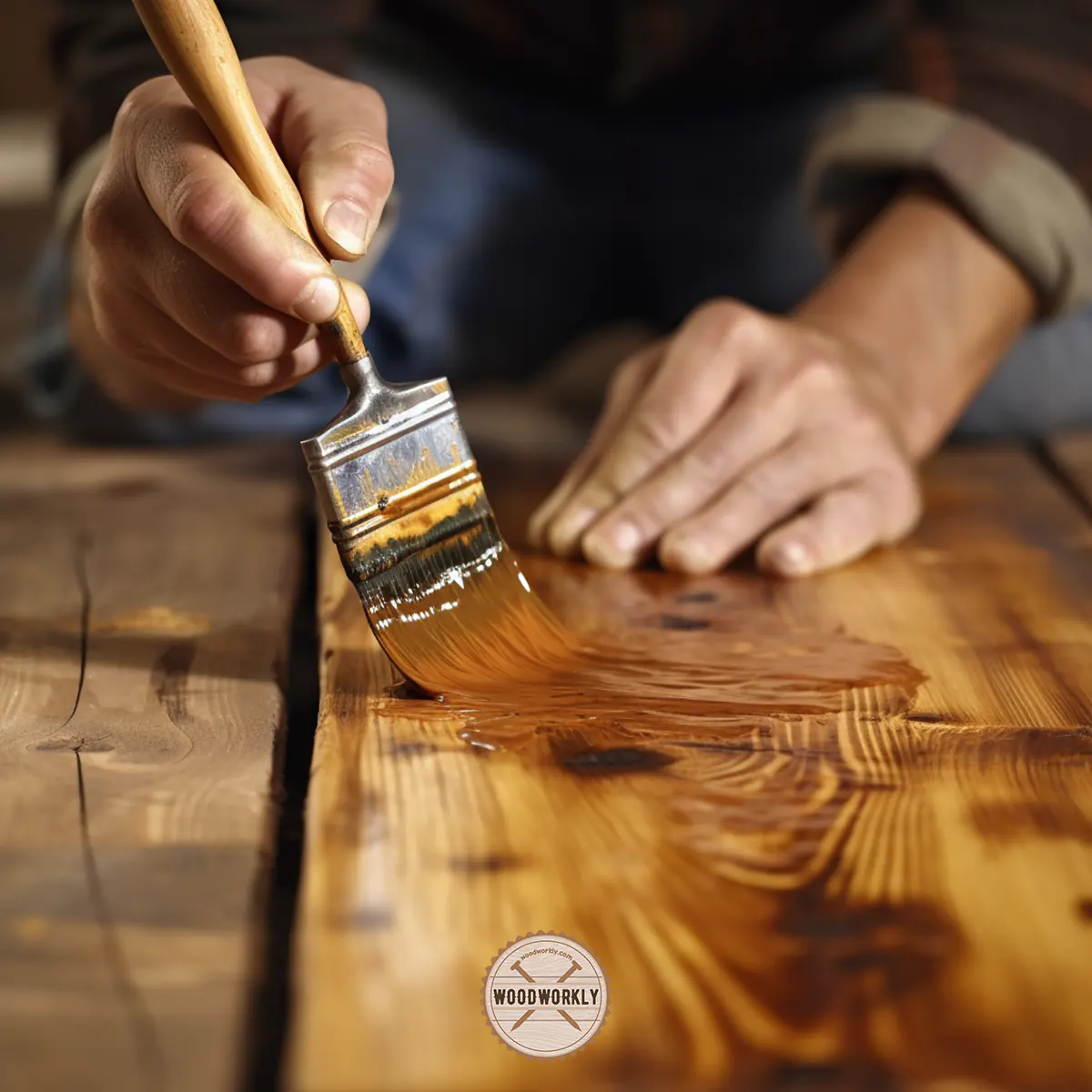
What Does Linseed Oil Do To Wood?
Linseed oil has a fantastic ability to bring out the richness and depth of the wood grain, transforming even the most ordinary pieces into works of art.
As the oil penetrates the wood fibers, it enhances the natural color, giving the wood a beautiful golden hue.
This golden tone eventually turns into a stunning amber color, giving your wooden piece a vibrant and warm appearance.
Whether it’s a rustic oak table or a sleek cherry bookshelf, linseed oil helps to accentuate the unique characteristics of the wood.
Provides Protective Layer
More than just a visual enhancer, linseed oil also serves as a barrier against environmental threats.
It repels water, helping to protect your wood from water damage.
However, remember it’s not completely waterproof, so high moisture environments might require additional protection.
The oil also displays some resistance against insects, pests, and fungal attacks, preserving the longevity of your wood.
Maintains Wood’s Condition
The elasticity of linseed oil deserves special mention.
As wood tends to expand and contract with temperature and humidity changes, a flexible finish is crucial.
Linseed oil’s elastic properties allow it to adjust along with these changes, thereby reducing the chances of cracks and maintaining the finish’s integrity.
Functions as a Wood Conditioner
Linseed oil also serves as an excellent wood conditioner.
For example, when you’re working with wood types like pine or birch, which can be challenging to stain, a pre-treatment with linseed oil can help.
It saturates the wooden surface, enabling the stain to spread out evenly and prevent common staining mistakes such as blotches and streaks.
Environmentally Friendly
And finally, linseed oil is an eco-friendly choice.
Being natural and biodegradable, it does not contain or release harmful substances into the environment, making it a great option for the environmentally conscious woodworker.
To sum it up, linseed oil works to enhance, protect, and maintain the natural beauty and longevity of your wood.
While it requires a bit of patience due to its slow drying time, the end result—a beautifully finished piece with a rich, deep color and resilient protection—is well worth the wait.
What Is Linseed Oil Used For?
Linseed oil is a multipurpose finishing oil that can be used for almost any kind of project.
Linseed oil is commonly used for,
- Stains and paints
- Cabinets
- Wood conditioner
- Window panels
- Doors
- Desks and chairs
- Bed frames
- Outdoor furniture
- Patio
- Boxes and crates
- Birdhouses
- Floorings
Linseed oil is eco-friendly and non-toxic finishing oil with high availability in local stores.
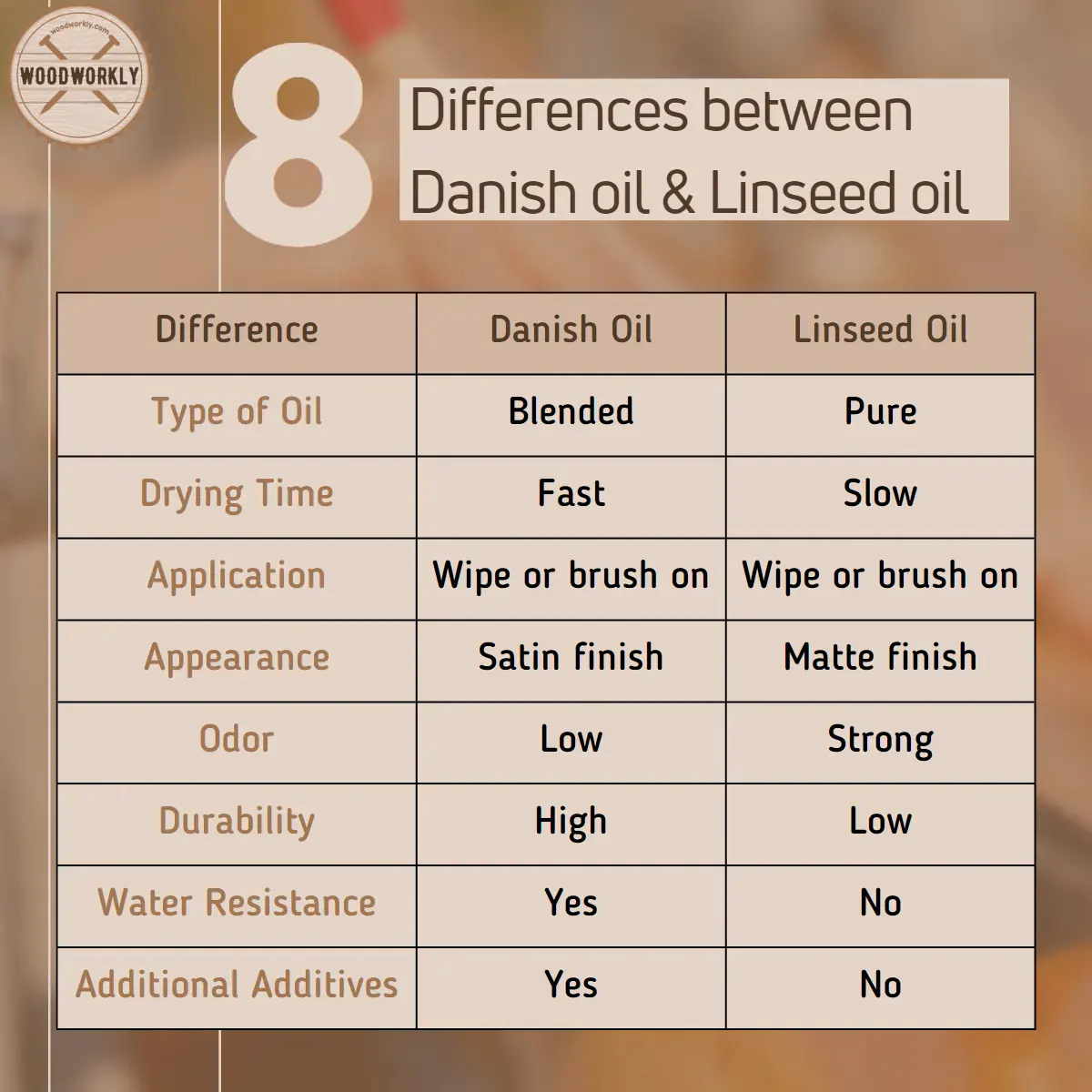
How Many Coats of Linseed Oil Should You Use?
3 coats of Linseed oil are ideal for almost any woodworking project. but this can vary on wood type, application type, and what type of protection you’re looking for.
Apply thin coats of Linseed oil on a wooden surface for better absorption and to dry quickly.
Because Linseed oil has the slowest drying time among popular wood finishing oils.
Can You Apply Linseed Oil Over Stain?
Better not to apply Linseed oil over stain because Linseed oil works well on bare or oiled wood.
Linseed oil penetrates through wood fibers to make them saturated to make a protective and attractive coating.
But because of having a stain, Linseed oil cannot penetrate easily through the wood. Therefore, Linseed oil doesn’t hold well on the stain.
Remove the stained surface first with sanding and then apply Linseed oil on bare wood for better even absorption and to gain a protective coating against environmental elements.
Can You Wax Over Linseed Oil?
Yes, you can apply wax over Linseed oil but wait for at least 48 – 72 hours until the Linseed oil coat is completely dried.
Wax protects wood from rotting and aging.
Wax helps to protect the wood from weather and increases the durability of Linseed oil coating.
Can You Apply Boiled Linseed Oil on Oak?
Yes, Linseed oil works great on Oak. It gives an enhanced natural look to
Oak wood with an excellent protective coating that protects Oak wood furniture and woodwork from environmental elements such as moisture, climate changes, insect attacks, and much more.
Apply Linseed oil on the sanded Oak wood surface along the direction of the wood grain using lint free rag or bristle brush.
Let the Linseed oil coatings dry completely on Oak before using it.
Apply 3 Linseed oil coats on Oak wood to get an awesome protective finish.
Can I Paint Over Linseed Oil?
Yes, you can paint over the Linseed oil surface. Paints hold well on the Linseed oil surface only if the paint is oil-based.
Therefore, always use oil-based paint over Linseed oil for better results.
Clean the Linseed oil surface with soapy water and let it dry completely.
Then do a light sanding with 400 grit sandpaper and apply a prime coat to seal the surface.
Then apply paint over Linseed oil without any issues.
Can You Apply Linseed Oil to Wet Wood?
Never apply Linseed oil on wet wood since it doesn’t hold well on wet wood.
Let wet wood dry completely and apply Linseed oil over dry wood for better results.
Applying Linseed oil on wet wood can cause blotches, and bubbles and ruin the appearance of the furniture.
Why Can’t You Use Boiled Linseed Oil On Oak?
While you can use boiled linseed oil on oak, it’s important to note that it may not be the best option for all oak projects.
The primary reason is that oak is a dense, heavy wood with a prominent grain pattern.
Boiled linseed oil, which penetrates deeply into the wood, can darken the wood significantly and obscure the grain pattern.
Additionally, boiled linseed oil contains additives to speed up drying time, which can sometimes react negatively with the natural tannins in oak, leading to discoloration.
For oak, oils that dry slower and penetrate less deeply may better preserve the natural appearance of the wood.
Hope you learned everything you wanted to know about, Linseed oil advantages and disadvantages.
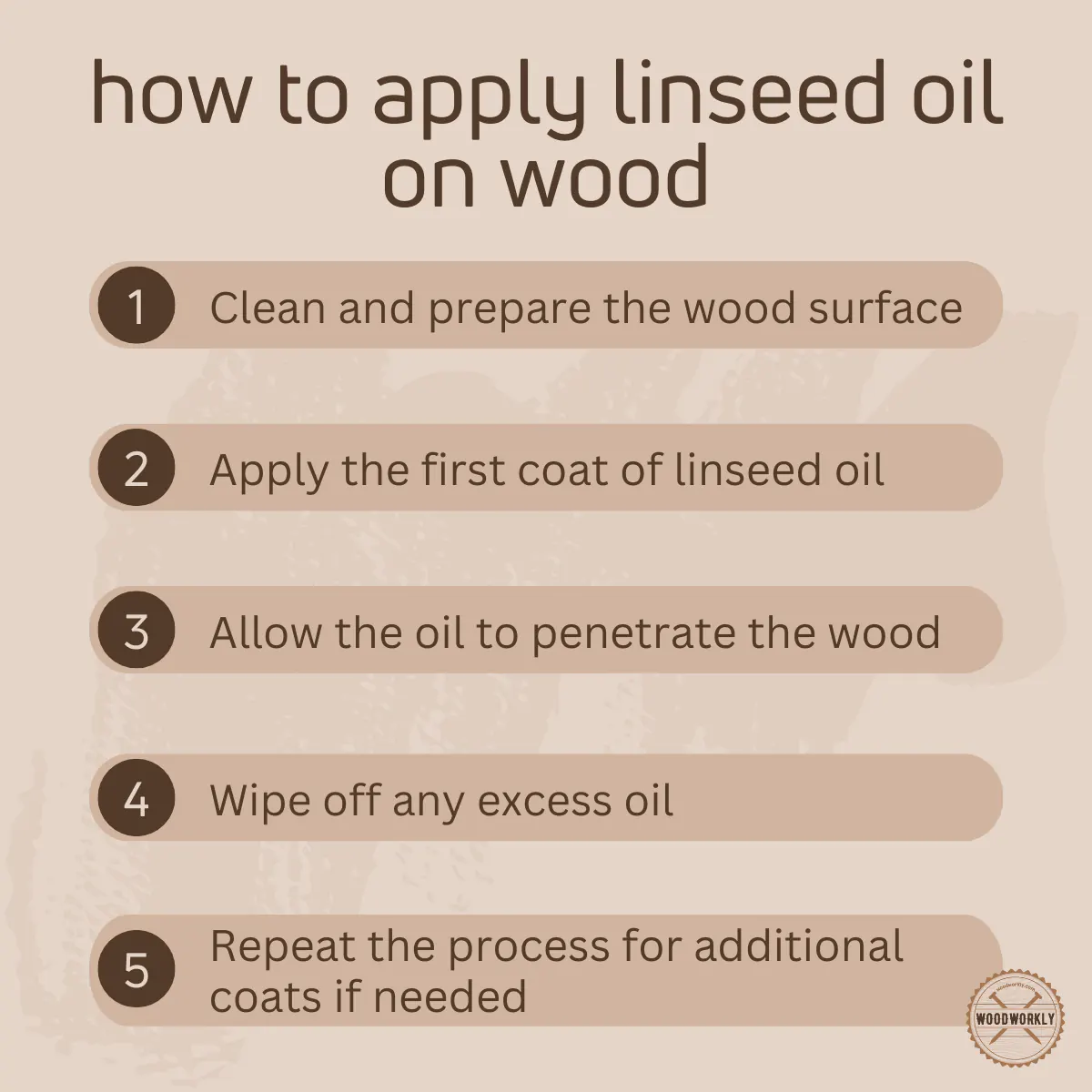
So, let’s answer some frequently asked questions about Linseed oil.
FAQs
What are the main advantages of using Linseed Oil?
Linseed Oil, derived from flaxseeds, has a host of advantages including enhancing wood’s natural appearance, hiding dents and scratches, and being non-toxic and eco-friendly. Moreover, it’s food safe, making it perfect for kitchen utensils, and also has good water resistance and elasticity.
How is Linseed Oil beneficial for wood appearance?
Linseed Oil works to enhance the depth of the wood’s natural color and texture, giving your furniture a refreshed, wet look. It provides a rich golden hue to your furniture that, over time, turns into a beautiful amber color.
Is Linseed Oil food safe?
Yes, Linseed Oil is food safe and perfect for use on surfaces that come into direct contact with food, such as kitchen utensils and countertops. However, only raw Linseed Oil is food-grade, boiled Linseed Oil can be harmful if ingested.
What makes Linseed Oil an eco-friendly option?
Linseed Oil is a sustainable and biodegradable product with no harmful chemicals or ingredients that would challenge the environment. Its production and application do not involve any substances harmful to the environment, making it a preferred choice for nature enthusiasts.
Why does Linseed Oil require regular maintenance?
Linseed Oil requires regular maintenance because the finish is not permanent and can attract dust particles, resulting in a dull appearance. The surface needs to be cleaned regularly and re-coated approximately every two years to retain its lustre and effectiveness.
Does Linseed Oil take a long time to dry?
Yes, Linseed Oil takes longer to dry compared to other wood finishes, typically requiring 2-3 days between coats. This long drying time can prove time-consuming, especially when several coats are needed for the best finish.
Why does Linseed Oil turn yellow over time?
Linseed Oil has a natural tendency to yellow over time due to a variety of factors including temperature changes, exposure to light, and certain chemical exposures. This yellowing can be more apparent when the finished item is placed under direct sunlight.
Does Linseed Oil provide UV resistance?
No, Linseed Oil does not offer UV resistance as it lacks UV filters or pigments to absorb UV light. Therefore, items finished with Linseed Oil should be kept out of direct sunlight to prevent UV-related damage.
Can Linseed Oil promote the growth of mildew?
Yes, Linseed Oil can support the growth of mildew, particularly when mixed with mineral spirits and exposed to high humidity. This can be mitigated with the application of high-quality stain on top of the Linseed Oil coating.
Does Linseed Oil protect against water rings?
Linseed Oil is water repellent but not fully waterproof. Therefore, it’s susceptible to water rings from cold glasses or spills, which can leave light-colored marks on the surface if not wiped off quickly.
Did I cover all you wanted to know about: Linseed Oil Advantages and Disadvantages
In this article, I’ve deeply discussed Linseed oil advantages and disadvantages and how to overcome its disadvantages and get the best out of it.
Linseed Oil, derived from flaxseeds, enhances wood’s natural appearance, hides scratches, is non-toxic, food safe, and eco-friendly. However, it requires regular maintenance, has a long drying time, can turn yellow over time, lacks UV resistance, supports mildew growth, and is susceptible to water rings.
Furthermore, I’ve answered some frequently asked questions about Linseed oil as well.
Hope you have gained good knowledge about Linseed oil advantages and disadvantages in detail.
Try Linseed oil on your next woodworking project and see how it works. Practice is what makes you perfect!